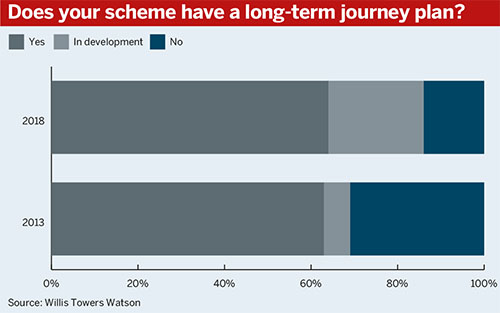Analysis: 2018 has been a very busy year so far for buy-ins and buyouts, with plenty of competition and attractive insurer pricing. But with demand predicted to rise, preparation is becoming key for trustee boards.
A record £7.8bn of pension buy-ins and buyouts were completed by UK pension funds in the first half of this year – up from £5.1bn in H1 2017, according to analysis by consultancy LCP.
The most important thing for trustees and advisers is to make sure that you’ve got all your ducks in a row before going to market
Harus Rai, Capital Cranfield
Willis Towers Watson research found that 37 per cent of defined benefit schemes are aiming for an insurer buyout, or a similar level of funding, as their long-term strategy.
Sixty-three per cent of trustees and 68 per cent of pension managers listed long-term journey planning among the three most important issues for them over the next three years.
Advisers can help gauge pricing
The busy first half of the year seems set to continue, with experts predicting that pension scheme demand for buyouts and buy-ins is likely to rise over the medium to long-term.
There are several factors that trustees and sponsors should take into account, if they want to ensure a good outcome for their schemes.
Shelly Beard, senior director of transactions at Willis Towers Watson, said trustees can use their advisers to guide them and give them an idea of pricing, before actually approaching the market.

Historically schemes would go to market to get an indicative price from a couple of insurers before they ran a full tender exercise. “I don’t think that adds value anymore, the insurers just don’t have time to do anything other than real pricing,” she said.
Clear objectives, good governance and communication between the trustees and the sponsor are crucial from the insurer’s perspective.
“If the insurer can see that both the trustee and the sponsor are aligned in their objectives for the deal, [and] there’s a very limited risk of one party pulling the plug at the last minute, then that will absolutely get more attention,” Beard said.
What does the insurer want?
Harus Rai, head of sole trusteeship at Capital Cranfield, said that “the most important thing for trustees and advisers is to make sure that… you’ve got all your ducks in a row before going to market”.
Trustees should show that they are serious about doing a buy-in or buyout, Rai noted, so being well-prepared is crucial.
Schemes should think in advance about what insurers want and likely requirements for data accuracy, he said, even four or five years out from a bulk annuity transaction.
Trustees can then spread any work and costs over time, and can eventually go to market showing that the scheme is ready to transact, he added.
Brush up on knowledge
It is also helpful for trustees to get to grips with how the industry works. “It’s very important they understand… the buy-in [and] buyout market, but it’s also important that you get the right advisers – and that might mean bringing in a specialist adviser,” Rai said.
Bulk annuity volumes break H1 record
UK pension schemes entered into a record £7.8bn of buy-ins and buyouts in the first half of 2018, as large 'back book' transfers between insurers failed to disrupt the market's capacity.
Beard agreed that there are a few things trustees need to be comfortable with before approaching the market. “It’s important that… they have a reasonable understanding of the process, in terms of the fact that it will take a couple of months,” she noted.
She added that schemes should be familiar with the main insurers in the market. Background knowledge on the insurance regime, and various protections in place to protect pension schemes that go ahead with transactions, is also useful.
However, they need not be experts. “In terms of having a really thorough understanding of exactly what’s going on in the market at the time, in my view [trustees] can largely delegate to their advisers to go out there and get them the best deal at the time,” Beard said, adding that advisers tend to have much greater visibility across transactions, and they can share that knowledge with the trustees.
Clear objectives are crucial
Richard Wellard, partner at consultancy Hymans Robertson, said one of the most important things for trustees when approaching the bulk annuity market is to have a clear idea of what the scheme and the company are aiming for.
“Both the trustees and the company should agree… what ‘good’ looks like for both of them, what they both need out of this transaction,” Wellard added.
He said there is often a working party or subgroup, with both trustee and corporate representatives, acting as the governance body for the transaction. This body does not necessarily make the decisions, but can be set up to set timetables and “make sure that things happen”.














